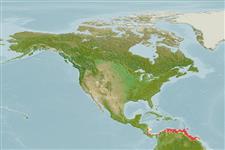Common names from other countries
>
Acropomatiformes (Oceanic basses) >
Synagropidae (Splitfin ocean-basses)
Etymology: Caraibops: Name from 'caraib', a collective name for the Indian tribes formerly inhabiting the Caribbean basin, combined with the ending -ops for the similar sounding to the related genus Parascombrops..
Environment: milieu / climate zone / depth range / distribution range
Ecologie
marien bathydemersaal; diepte 36 - 550 m (Ref. 9626). Deep-water; 13°N - 6°N
Western Atlantic: from NE Gulf fof Mexico to Suriname.
Grootte / Gewicht / Leeftijd
Maturity: Lm ? range ? - ? cm
Max length : 11.5 cm TL mannelijk / geslacht onbekend; (Ref. 9626)
Dorsale stekels (totaal) : 8 - 9; Dorsale zachte stralen (totaal) : 10; Anale stekels: 3; Anale zachte stralen: 8 - 9; Wervels: 25. This species is distinguished by having an elongate body, slender head; clearly separated first and second dorsal fins; pelvic spines with anterior edge distinctly serrated; anterior edge of second spine of first dorsal and anal fin smooth; A III; D1 XIII; 46-51 pored lateral line scales; weakly serrated posterior margin of preoperculum; both jaws with a single row of teeth; canines long, sharp, well separated; upper jaw with 3-4 prominent fanglike teeth anterior to the vomer and without large canines on premaxillary; lower jaw with 2 small canines at front, followed by 3-5 large canines; 2 canines on vomer; villiform teeth on palatine (Ref. 80062).
Encountered near the surface at night.
Levenscyclus en paargedrag
Maturities | Voortplanting | Spawnings | Egg(s) | Fecundities | Larven
Mejía, L.S., A. Acero P., A. Roa and L. Saavedra, 2001. Review of the fishes of the genus Synagrops from the tropical Western Atlantic (Perciformes: Acropomatidae). Caribb. J. Sci. 37(3-4):202-209. (Ref. 43234)
Status op de Rode Lijst van het IUCN (Ref. 130435)
CITES (Ref. 128078)
Not Evaluated
Gevaar voor de mens
Harmless
Gebruik door de mens
Tools
Speciale rapporten
Download XML
Internetbronnen
Estimates based on models
Preferred temperature (Ref.
115969): 13.1 - 22.4, mean 18 (based on 26 cells).
Fylogenetische diversiteitsindex (Ref.
82804): PD
50 = 1.0000 [Uniqueness, from 0.5 = low to 2.0 = high].
Bayesian length-weight: a=0.00955 (0.00424 - 0.02152), b=3.02 (2.82 - 3.22), in cm Total Length, based on LWR estimates for this (Sub)family-body shape (Ref.
93245).
Trofisch niveau (Ref.
69278): 3.4 ±0.5 se; based on size and trophs of closest relatives
Fishing Vulnerability (Ref.
59153): Low vulnerability (10 of 100).
